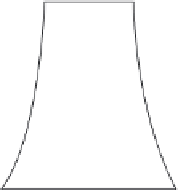Environmental Engineering Reference
In-Depth Information
P
T
CP
CP
B
4
1
1
B
4
3
2
3
2
v
s
(a)
(b)
FIGURE 5.2
Diagram for a simple ideal Rankine cycle. (a) on P-V diagram and (b) on T-S diagram.
A
D
C
Combustion gases
to stack
+
Electric
generator
Turbine
Boiler
-
Cooling
tower
Fuel
Condenser
Air
Warm water
B
Pump
Cooled water
Feedwater pump
Makeup
water
FIGURE 5.3
Schematic of a simple ideal Rankine cycle.
The working fluid (at State 2) is at a low pressure but has a fairly high
quality, so it is routed through a condenser, where the steam is condensed
into liquid (State 3). Finally, the cycle is completed via the return of the liquid
to the boiler, which is normally accomplished by a mechanical pump.
The efficiency of a Rankine cycle is usually limited by the working fluid.
Without the pressure becoming supercritical, the temperature range over
which the cycle can operate is quite small; turbine entry temperatures are
typically around 565°C (the creep limit of stainless steel) and condenser
temperatures are around 30°C. This gives a theoretical Carnot efficiency of
around 63% compared with an actual efficiency of 42% for a modern coal-
fired power station. This low turbine entry temperature (compared with a
gas turbine) is why the Rankine cycle is often used as a bottoming cycle in
combined cycle gas turbine power stations.


































































